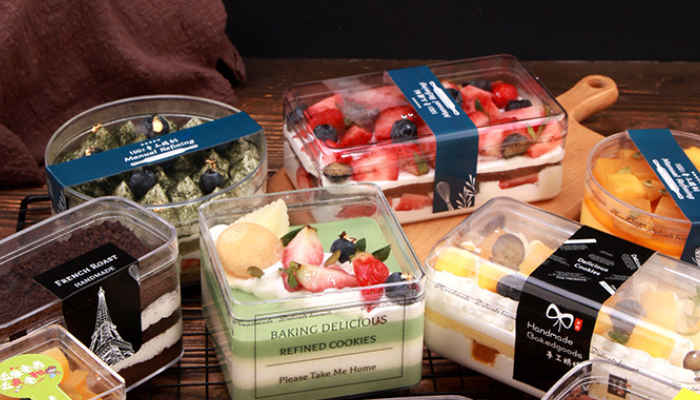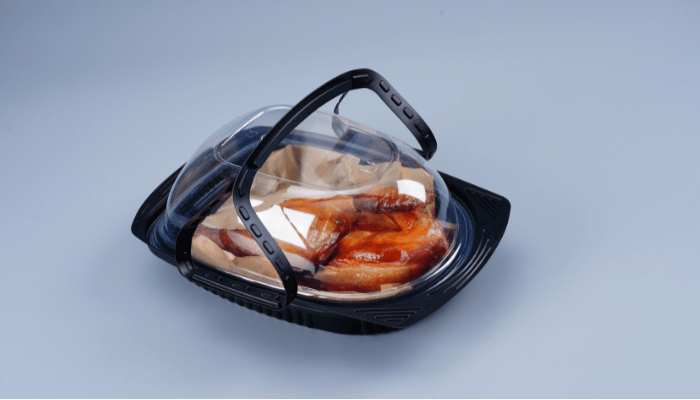The rules for using food-grade materials wherever food may come into contact, especially packaging, have led to the development of food-safe plastics for packaging consumer products. So, food-grade plastics follow a rigorous manufacturing process to ensure they are safe from contact with food. Then, this article delves into the intricate world of plastic food packaging, focusing on 4 types of plastic food packaging: PET, PP, PS, and OPS.
Polyethylene Terephthalate (PET)
PET is a thermoplastic polymer that is a standard engineering plastic. The materials are commonly used to manufacture various products, including plastic bottles, fibers, films, and industrial yarns. The molecular structure of PET, characterized by its long-chain polymers, imparts exceptional strength. At the same time, PET has good resistance to most chemicals and is not susceptible to corrosion. It also has good heat resistance and can withstand temperatures within a specific range. These characteristics make it a preferred choice for beverage bottles, food containers, and other packaging.
Due to the recyclability of PET material, it has become one of the primary materials for plastic bottle recycling. Through recycling and reusing, it can reduce resource consumption and environmental pollution. But people’s concerns about recyclability have been raised. The recycling process for PET involves melting the plastic to reform it, a cycle that may impact its quality over time. So, this underscores the need for advancing recycling technologies to enhance the sustainability of PET packaging.
Key Attributes of PET:
- Transparency and Clarity
- Resilience
- Recyclability

Polypropylene (PP)
Moving forward, let’s focus on Polypropylene(PP). PP is a lightweight plastic with a low density, making it ideal for manufacturing lightweight products. PP has a high melting point allows it to maintain its shape and properties in high-temperature environments. This thermoplastic polymer has excellent heat resistance and robustness, making it suitable for hot-fill applications like microwaveable containers.
In addition, recyclability is emerging as a critical strength for PP, with a relatively high market demand for recycled PP. The challenge lies in the efficient collection and processing of PP materials, highlighting the importance of community-led recycling initiatives to optimize the environmental benefits of this packaging type.
Key Attributes of PP:
- Thermal Resistance
- Microwave-Safe
- Lightweight

Polystyrene (PS)
Polystyrene (PS), a polymer uniting styrene molecules, embraces a dual identity — rigid and foamed. This duality extends its application spectrum, from disposable cutlery and CD cases to expanded polystyrene (EPS) used in protective packaging.
Under ASTM standards, polystyrene is regarded as not biodegradable. Even if PS has some advantages in applications, it also raises environmental concerns because it is difficult to degrade. Some regions have taken measures to restrict or ban the use of disposable PS products, promote alternative materials, or enhance the recycling and reuse of PS.
Key Attributes of PS:
- Rigid and Foamed Forms
- Cheap
- Environmental Considerations

Oriented Polystyrene (OPS)
OPS materials are typically more transparent than traditional PS, making them suitable for applications requiring high transparency, such as transparent packaging. They also have higher strength and rigidity.OPS exhibits better thermal stability in some areas, making it suitable for high-temperature processes, and lending to applications like clear cups and trays.
By the way, recycling challenges persist with OPS, paralleling the concerns associated with traditional PS. To address these challenges becomes crucial for establishing a comprehensive and sustainable approach to material usage.
Key Attributes of OPS:
- Clear Transparent
- Enhanced Strength
- Thermal Stability

As consumers navigate the supermarket aisles, armed with awareness about PET, PP, PS, and OPS, making informed choices becomes a tangible reality. Sustainability emerges as a recurring theme, urging stakeholders to embrace innovations in biodegradable plastics and explore the realms of circular economy practices.
In conclusion, the discourse on plastic food packaging transcends the conventional, beckoning an era where knowledge intertwines with responsibility. The intricate dance of PET, PP, PS, and OPS showcases the ceaseless evolution within the packaging industry, urging us to be discerning custodians of our consumption choices. As the world grapples with environmental challenges, the onus lies on both producers and consumers to foster a symbiotic relationship with our planet.
Conclusion
In this article, we look at the complexities and differences between these types of plastic food packaging materials such as PET, PP, PS, and OPS. These materials play a unique role in food packaging, each offering a range of properties and advantages. In this diverse plastic packaging market, understanding the properties of each material is critical to meeting the needs of different applications.
However, as concerns for sustainability and environmental protection continue to grow, we must also seriously consider the importance of alternative materials and recyclability to facilitate the development of more sustainable packaging solutions. We can better guide and promote sustainability in the food packaging industry by considering material properties, performance, and environmental considerations.



